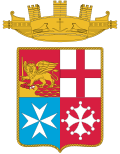 Coastal oil tanker Capri (A 5353), 2007 | |
| Class overview | |
|---|---|
| Name | Gorgona |
| Builders | Cantiere Navale Mario Morini, Ancona |
| Operators | |
| In commission | 1986-1987 |
| Planned | 6 |
| Completed | 6 |
| Active | 6 |
| General characteristics | |
| Type | Coastal Transport ship |
| Displacement | |
| Length | 56.72 m (186 ft 1 in) LOA |
| Beam | 10.00 m (32 ft 10 in) |
| Draught | 2.60 m (8 ft 6 in) |
| Propulsion |
|
| Speed | 14 knots (26 km/h; 16 mph) |
| Range | 1,800 nmi (3,300 km; 2,100 mi) |
| Crew | 34 (of which 2 officials) |
| Sensors & processing systems | 2 x GEM Elettronica MM/SPN-753 navigation radar |
The Gorgona class is a series of six Coastal Transport ships of the Italian Navy, named as Moto Trasporto Costiero, MTC.



